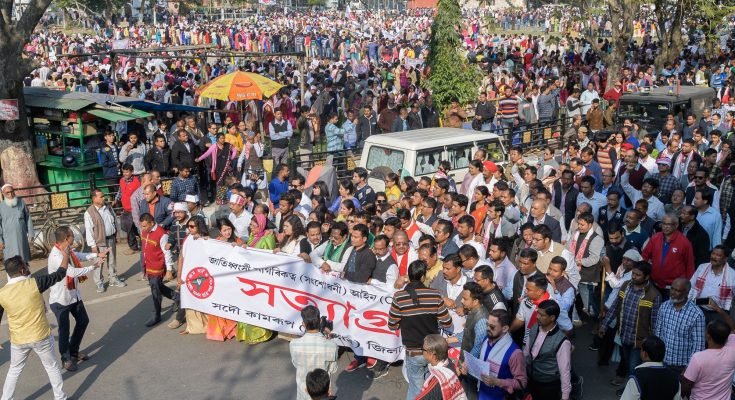Photo credit Prakash Bhuyan
It was a week of mourning for some and deep reflection for many others around the world as news broke of the passing of Queen Elizabeth II. While scrolling through the many updates about her funeral, I noticed a tweet from Cronkite News about mourning “British expatriates” in Phoenix. While the Brits had my condolences, I was left disturbed by the casual reference to them as ‘expats.’
Were they actually expats, meaning temporary residents on a work, visitor or student visa? Or were they long time residents, who owned property or land or even voting rights? I had to ask these questions.
Reporting on migration in India, I have long pondered over how certain immigrants become public enemies while others are lauded for their contributions. In the States, migrants from across the Atlantic are referred to as ‘expats’ while long-time settlers from right across the border in Mexico or the proximate South Americas are denigrated as ‘immigrants.’ Likewise in the Northeast Indian state of Assam, settlers from the Western and Central Indian belts are often seen as more ‘Assamese’ than those from neighboring West Bengal and Bangladesh. In fact, the latter are casually remarked as bideshis, foreigners.
Sometimes it can turn ugly, as I have witnessed. In December of 2019 Guwahati – the city I had settled down a year ago – was in shambles. Ordinary citizens stood guard at road blockades every 50-100 meters whilst the young and old picketed, destroyed public property, inscribed graffiti against politicians and raised slogans.
The public felt betrayed. Just a day before, the Indian parliament had given a nod to the Citizenship Amendment Act, a highly unconstitutional law that would grant naturalisation rights for non-Muslim migrants from Afghanistan, Pakistan and Bangladesh. Assam was the first state to violently object, much before protests broke out in New Delhi, Mumbai, Bangalore.
And there was another difference. While in other places ordinary Muslim housewives protested against the law because it targeted the Muslims, the Assamese stood up against protection of the Hindu Bengali immigrants in their state. For the Hindu nationalist federal government, Hindu migrants from neighboring countries were ‘refugees’ whilst Muslims were ‘termites.’ But in Assam, where the history of migration follows from the time of undivided Bengal, the religion of ‘illegal foreigners’ mattered less than where they came from.
Everywhere I went reporting during the protest, there was a real panic about an imagined invasion of millions of migrants from Bangladesh. The fact that Bangladesh is fast progressing into a developing nation compared to Assam’s sluggish economy didn’t matter much in a post truth era. The atmosphere had already been vitiated with propaganda about millions of illegal foreigners already living here. Breaking curfew, risking arrest and police firing (killing five protestors), people were ready to lay down their lives to ostensibly protect their motherland from being overrun by foreigners. Public sentimentality was at an all time high and their heart was sincere, even if it came across to me as insensitive to the thousand innocents who were for years imprisoned in detention centers meant for illegal foreigners. There has never been this scale of a protest to shut down or even improve these detention centers, where 30 persons have died because of unsanitary conditions and poor health services.
It didn’t help that four months ago, the National Register of Citizens (NRC) – a five year long exercise in the state where 30 million applicants submitted proof of residency prior to 1971 – finally came to fruition. The Assamese nationalists expected at least a 100 million Bengali speaking residents to be out. Instead, the list excluded just 1.9 million applicants – more Hindus than Muslims, leading the government to reject the outcome. What was meant to be a list that finally determined the number of ‘illegal immigrants’ in the state since the creation of Bangladesh in 1971 had been repurposed by the nationalist government as yet another tool to persecute 200 million Muslims in India.
Once I started reporting on the register, I realized that citizenship trials going on for more than 30 years in Assam had already cast over 500,000 persons under suspicion. I was amazed by this vast architecture of federal laws and procedures on immigration. In Assam, it functions on steroids backed by the common myth of ‘marauding’ migrants – a term used already by a British administrator in 1931. I call it a myth because the same state that prosecutes these ‘illegal foreigners’ does not have the proportionate data to back it up. But what intrigued me most was how the locals were hostile to a particular linguistic group when the state itself was made up of people from diverse ethnicities, languages and regions.
My curiosity led me to investigate how Assamese nationalists in collusion with state agencies had inflated migration statistics by framing ordinary citizens – poor people of Muslim and Bengal origin – as ‘illegal foreigners’. Due to Assam’s citizenship process, people like former Border Police official Mohammad Sanaullah and daily wage laborer Abubakkar Siddiqui spent several days to years in a detention center and were cursed to a “legal purgatory of statelessness.” They had no rights, no liberty, no life.
The anger against the government that was once so palpably visible in Assam has died down and people voted to bring in the same government for a second term. Much of that anger has since been directed towards the already vulnerable Bengali Muslims who have been vilified as Covid super spreaders, illegal squatters and terrorists. To lay these facts bare to people in my home city would only invite their wrath and social media trolling – a group of local journalists once included me in a public list of ‘anti NRC’ journalists. Quite unlike a senior editor of Cronkite News, who welcomed my feedback on the use of ‘expats’, saying: “It’s one we’ll bring to our team here as we continue to work through unconscious biases.”
As I write this blog in the middle of September, the temperature is slowly on the decline in Arizona, but the election heat is on with the governor’s race and midterms coming up. All the hysteria about immigration – like the Republican candidate Kari Lake calling all immigrants criminals – oddly makes me feel less homesick.
But as we debate from the comforts of our air-conditioned spaces, we cannot even begin to imagine conditions under which migrants are crossing the desert to reach the rusting steel walls and shipping containers guarding the border. Nor the conditions that compel them to leave their homes. Still, it is worth trying, because with climate emergencies becoming as regular as military coups, wars and economic crises, it is migration that is making the world smaller, not Facebook.
Although we all have every right to be protective of our homeland, we often tend to forget the past and the future. The history of our own migration or that of our forefathers, which may have (violently) wiped out the earlier settlers. And the possible future that one day, we too – like the Syrians, Latin Americans, Afghans, Ukranians, Burmese and South Asians now – may have no other choice but to leave our homeland.




